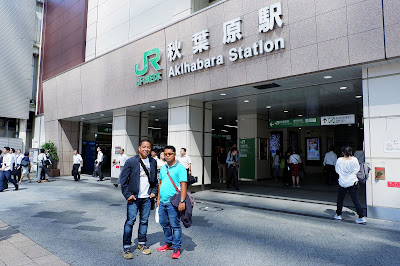After a tough Mt. Fuji climb, our team had enough time in Tokyo that we were able to beat the chance roaming around several popular destinations. Tokyo is a highly urbanize city and although time is of a requirement there is no problem in the transportation because the train transport in the area is very comprehensive, distributing number of stations in almost all key city sites. Here are six sites we visited and enjoyed before flying back to the Philippines last September 10.
SENSOJI TEMPLE
This
is a popular Buddhist temple located in Asakusha. The trading streets and
beautiful temples laid out in the entire location have become points of
interest, making it one of Tokyo’s most vibrant sites. Souvenir items and street
foods of assorted varieties can be bought here. Some local beliefs are being
practiced here also. Sensoji Temple is considered as the oldest temple in Tokyo
and it presents a historical significance of Japan.
SHIBUYA DISTRICT
Shibuya
is a major commercial and business center as it houses the busiest railways in
the world. This area is a fashion center in Japan, from it rises beautiful
thumbnails which represents Japan in almost all virtual platforms.
Aside
from the busy thoroughfare, another attraction on the other side of Shibuya is
the replica of Hachiko, an Akita dog born on a farm near the city of Odate. He
is remembered for a heroic act as good friend and servant to his owner that he
never leaves until his owner dies.
AKIHABARA DISTRICT
This
is a district situated in central Tokyo known for its many electronic shops. It
is Tokyo’s major shopping center for household electronic goods. We went there
and had some good buys. Prevalent images and items of manga and anime are being
displayed in Akihabara.
IMPERIAL PALACE
Two
days before flying back to the Philippines we visited Imperial Palace, an abode
in Edo Castle site where the Imperial Family resides. I was amazed by the
remarkable channels and stone wall structures built within the circumference of
the place which are being melded by the green landscape made up of familiar
Japanese ornamentals. It is a living vestige that depicts historical and cultural
significance of Japan, allowing them to open it to the public for educational,
as well as for aesthetic reasons.
UENO PARK
This
open park in Tokyo is a public refuge for people who want to take respite
amidst busy city life. After roaming
around Ueno District we took a breather here and mingled with the tamed black
birds. Around the park there are plenty of food and shopping stalls to satisfy
ones spending habit. The one thing we
missed in Ueno Park is the trees that turned into cherry color during spring, a
very festive scenery.
SKYTREE TOWER
This
tower is the tallest in the entire Tokyo and reached its height to 634 meters
in 2011, making it the tallest tower in the world, lodging out the famous
Canton Tower in China. It is located in Sumida. An outdoor viewing tour in
Skytree can also be paired with shopping as there are malls within the district
that serves as a component to the tower premises.
Personally, I think
of Skytree tower as another expression of how great the Japanese are in terms
of architecture and engineering. Somehow it declares persistence of the people
and a statement that Tokyo, or Japan in general, is one of the most developed countries
in the world.








































